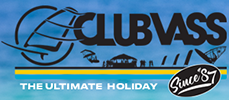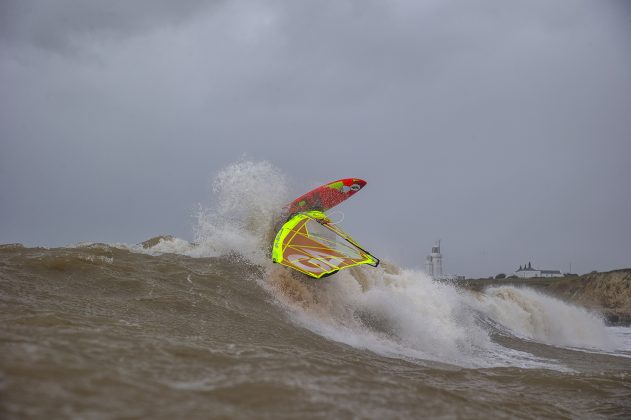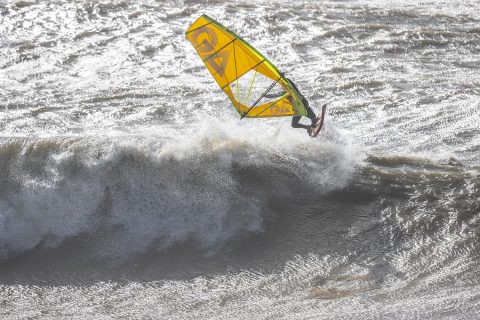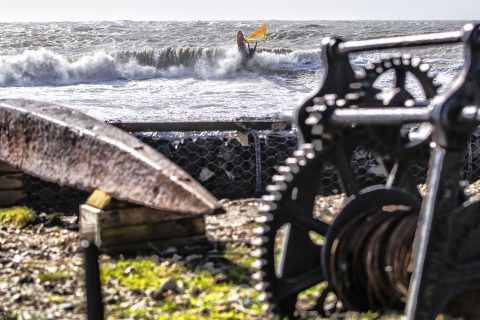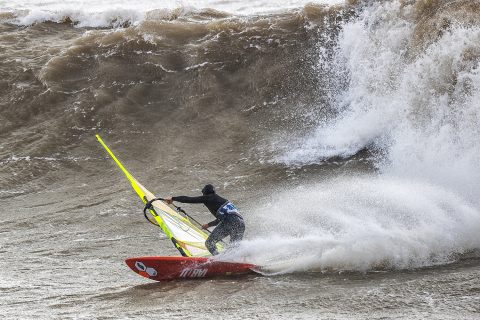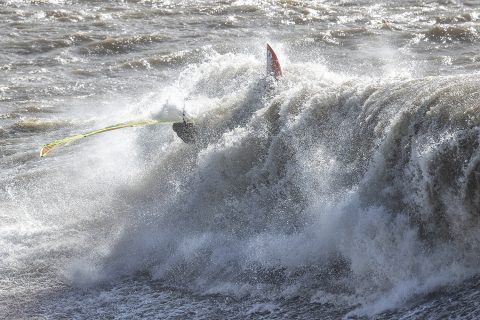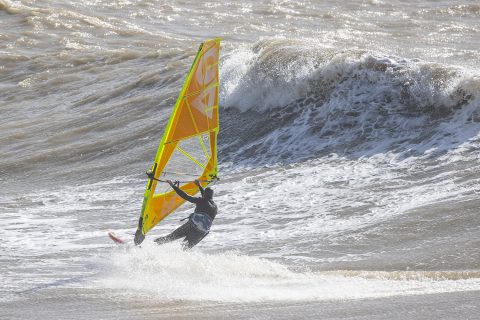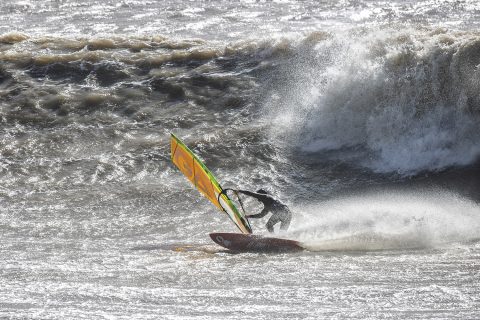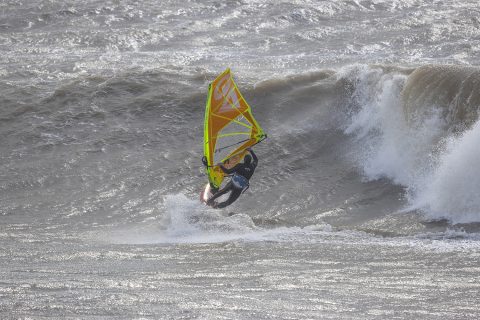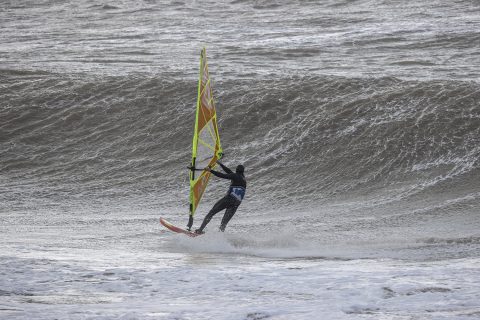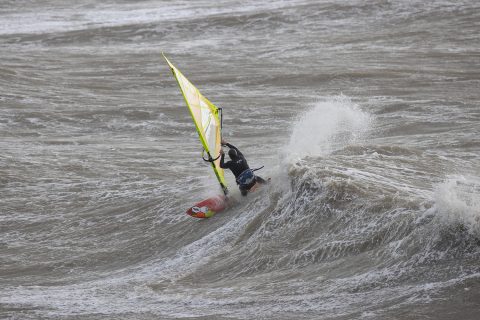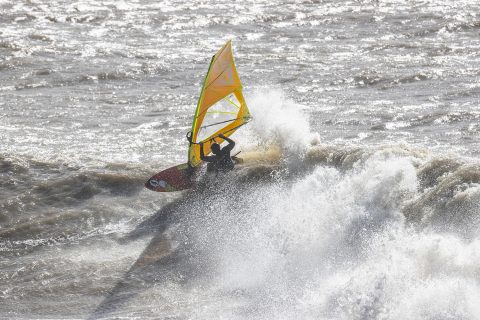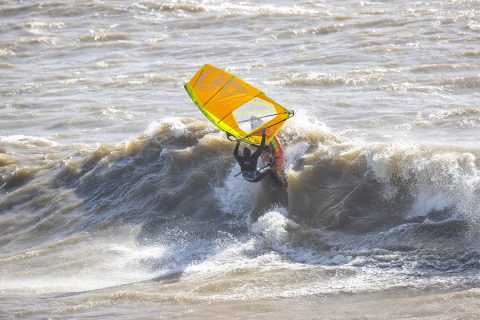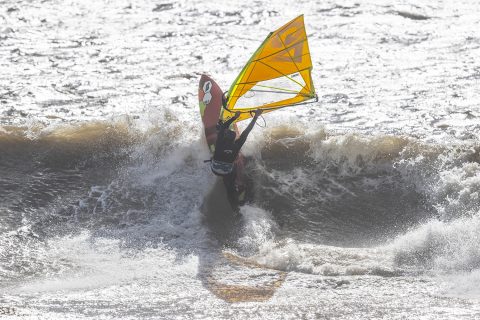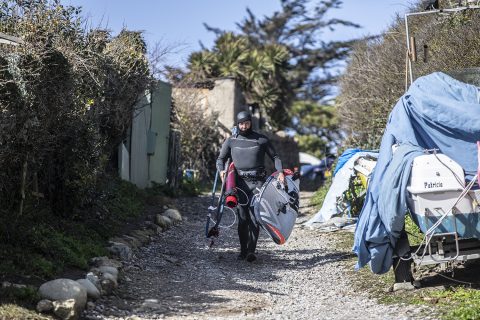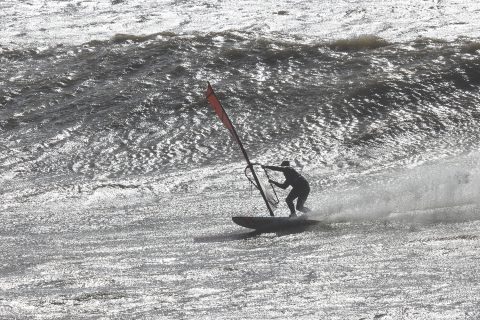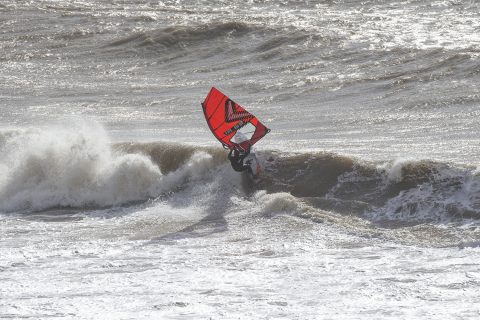Ross Williams might be a renowned racer, but he is also known for his ability to rip in any conditions. Along with Timo Mullen, he gives us some tips on making the most of typical cross-onshore wave riding conditions in the UK.
WORDS – ROSS WILLIAMS, TIMO MULLEN // PHOTOS – JOHN CARTER
ROSS WILLIAMS
The regular conditions for most sailors in the UK are not cross-off down-the line-perfection. We have to make the most of what we have available. Even if it is side-shore, quite often the waves are bending away from you, meaning you have to sail clew first a little bit and feather your rig to keep the power towards the section that is going to break.
- Ross Williams
My home spot, Niton on the Isle of Wight, I kind of know like the back of my hand. The wind can be all the way from slightly side-on, through the angles to side-off. The waves come in at all different directions, depending on if it’s ground or wind swell. I know the spot and the wave so well, I feel I can predict where the wave will be throwing and work out my angle of attack appropriately. I keep my sail nice and open and approach the wave clew-first so I can look towards the section that I want to hit. I try to balance and use the power in the sail to pull me towards the wave, so I have as much power as I can when I reach my manoeuvre.
- Niton
In slightly cross-onshore, or with a wave bending away from you, there usually tends to be a bit of a wind shadow. There can also be a bit of current on those days. So, to try and keep your speed up you really have to anticipate all your moves in advance and read where the section you are going for is about to break. So, when I am on a wave, I am kind of planning ahead of time where and when I will hit the lip. Before I even drop down into a wave and go into my bottom turn, I am looking down-the-line, sizing up the section. I will start upwind of the A-frame of the section. My plan is usually to hit the first big section if I can and then work down-the-line after my initial move. You need to make sure you have enough space that your turn will not be too tight! Otherwise, you can stall all the speed. By the same token if you are too far away from the wave, you will also lose speed when trying to make the section.
So, looking ahead before engaging in that first bottom turn and then as you go into the turn, keep your sail as open as possible to the wind. So that aids you and keeps your speed flowing through the turn and pulls you towards the section you are aiming at. While you are looking at the section you are opening your back hand and almost following your leading hand, and will be heading clew first towards the section.
HANDS
To get any kind of power from a turn and have maximum stability, opening up your arms with your back hand quite a lot further back enables you to have more play and say of operating where your sail is going to go. With hands further apart you have more options and freedom to throw your body and lean off the sail. Having a wider stance makes you more connected to the sail. If you have a narrower grip on the boom, then the sail is going to feel a bit twitchier, and if you go to really lean in on a turn, the narrow grip just makes the rig a bit unstable. A nice wide arm stance keeps you closer to the sail and more connected.
- Bottom turn action
BOTTOM TURNS
The bottom turn is obviously different in side / side onshore. If you are used to sailing perfect waves in cross-offshore winds, obviously the bottom turn is an awesome feeling. But in cross-onshore conditions there is definitely an art to having a nice driving bottom turn and cross-on top turn. You have to anticipate what the wave will throw at you, maybe even more than in cross-offshore down-the-line. You need to read the situation, the waves and the conditions quite a way before the moment when you are going to do your move. Your plan is a lot more thought out.
PLAN OF ATTACK
The first thing when I drop in is to get my speed up and make sure that I am able to approach the section round about the right area of the wave. Once I am there, the wave will offer me various options. It might be a critical section that you could either go for a 360 on, because that move will flick you back over, or if you are slightly away from said section, then it might set up better for a power carve in the pocket and send a bit of spray. If you are coming from behind the section then you are going to hit it as it has already broken because you are maybe a fraction late. Then you are going to integrate that into a nice top turn or even a taka. The bottom turn sets you up for all the options. As you are in that bottom turn and heading towards the next part of the wave, then you can gauge if it is a 360 section or a part of the wave you can hit. You will know what move you are going to do before you get there, but you leave the options on the table.
- Ross in deep
CLEW FIRST
The clew first bottom turn leaves you open to how the wave unfolds. What you thought might be a section that was going to throw, may back off to leave an open face. When I go into my bottom turn, as I am powering up, I almost go onto my front foot. I lean in on my front foot and try and keep the pressure on that foot so I keep my weight forward. I might want to extend the bottom turn depending on how the wave is forming. If I am on my back foot, I will be more likely to stall the speed. Once I am on the front foot, I am looking at the section and I can decide my move, for instance a 360 and continue with my front foot pressure all the way round until I am in that motion of the final flick of the board and sail in the 360. If I am going into a top turn, I will switch my weight to my back foot as I am driving into the top turn. Back foot to front foot!
CROSS-ONSHORE
I think it feels really awesome when you nail a really nice powerful turn in cross-onshore. It is a very satisfying move and believe me, I have sailed a lot and ridden thousands of waves to be able to do this well. It is a lot harder than in down the line conditions where you are tending to be in a more predictable environment and the wave is doing a lot of the work for you. In onshore, there is a lot more reading of the sections and unpredictable situations. Sometimes you have to extend the bottom turn, stall, or resort to a different move at the last moment. There are a lot more minor adjustments to be made!
GEAR
A guy like Brawzinho is super in tune with his wave sailing gear. He almost has a different board for every condition. I am ‘Mr Production’ and go on a standard board usually with standard settings. I might play around with fin position. I only use thrusters and usually, it is the front fins that I move around not the back one. The back fin I have directly under the back footstrap. If I am looking to do a more sliding turn I might move my fins closer together. If I want more grip or more power, then I will spread them out a little bit. On my side fins I prefer to have a cant on them and also toed in. Fin cant is the degree of outward angle a fin has in relation to the bottom of your board. If a fin has zero cant, its position is straight up and down, more cant means the fins are angled outwards towards the rails in the vertical plane Fin toe in refers to the angle the fin points towards the centre of the board, so my fins are ever so slightly facing in as you look down the board. The toed in aspect sharpens my turns up and gives me control and grip. Both cant and toe in together allows me to turn on my side fin as an axis and do tighter turns. When I am turning I get more drive this way. That allows me to have a smaller side fin, but gives the feeling of having a bigger fin with more control and bite. In theory it should keep me turning tightly with more power. Having my fins set up this way means I can use a smaller fin, which also allows me to have a bit more speed.
MOVES
Nowadays you can do all the moves in cross-onshore. When I was competing more, it was rare we competed in side-offshore, so knowing how to wave ride well in cross-onshore was essential. It is good to be able to sail in all conditions. Cross-onshore is all about timing, power and keeping your speed. With no speed you are not going to be able to hit the right part of the section, produce spray or do any of the tricks needed to win events. If your timing is off then you are going to be shooting off down past the section and missing the best part of the wave. If you have no power in the sail, then generally you are a bit unstable with your equipment. Even if you do try to do moves and you are in the right place, without power in the sail to help you recover then a lot of the time you will be eaten by the whitewater and fall off.
TIPS
For regular sailors I feel like they don’t commit enough to what they are doing and they don’t exaggerate the cross-on style enough. I tell guys to move their hands further apart and open the sail. In their eyes they are feeling like they are doing it, but when you look at them it tends to be only halfway there. It is best to exaggerate the keys things, looking where you are going, your hands further apart and just repeat doing the same thing over again. The amount of repetition that you do just allows you to read the situation better. If you are at your local spot and you sail that most of the time, then you will have a good understanding of how the waves and wind work there. It is just the technique and what you are doing with your equipment that is not allowing you to sail better in cross-onshore conditions. It is all about keeping speed and power. In side-onshore people sometimes take a sail that is a bit small. I like to have power in those wind shadows in front of the wave. It is not so nice for jumping when you are overpowered on the way out, but it all balances out when you are on the wave.
A bigger board also helps in cross-onshore conditions. Just because it adds a little bit more flotation. So you are less reliant on getting so much power from the sail. The tendency is for sailors to drop to a board with too small volume. I would say go slightly bigger than what you would use in perfect conditions. Give yourself a bit more power and floatation, which will enable you to recover from mistakes.
- PIC 1
I am leading with my back hand and you can see that I am looking directly at the section of the wave I want to hit. I am leaning quite far with my body and hanging off the sail to keep it upright. I need the power in the sail to drive me towards the wave so I can have a powerful hit. The basics are all there though. My arms are locked out, I am looking where I am going and where I am intending to hit the wave.
- PIC 2
This is a bigger wave and I am coming around the section. You can still see the sail is leaned over. I have good speed in this shot so I am able to lean the rig over more. The sail is still open towards the wind. That shot is still cross-onshore. As soon as I come out of that bottom turn, I am going to be hit by that wind. That is a nice looking turn. The board is really engaged and you can see the drive coming off of those rails. The power is coming from the sail, through me and onto the board. It is a really nice driving position. I look like I have quite good control there.
- PIC 3
In this shot you can see I have gone past the breaking wave. If I were going to do a normal turn it would be on a flat section. So it looks like I have weighed up my options to go for a big 360. I am carving up harder and harder and looking at the section that is going to flick me back through the 360. Once you have done enough 360s you can make quite a high percentage of the attempts. I actually find them quite easy at Niton.
- PIC 4
In this shot, I am almost stalling on standby. You see the board is sitting flat. I am trying to lean a bit on my front foot and using the sail, which is nice and upright to balance on. I am waiting to see how the wave is going to set up. Then I have the option to go for a 360 or a turn depending how the wave breaks.
- PIC 5
I think I was getting blown out a bit in this shot, so my timing might have been a bit off. If the wave were a bit steeper it would have been nice to hit it. The sail has too much power in it and sometimes it can get ripped out of your back hand.
- PIC 6
The downside to onshore wave riding is that there is usually a very small critical section of the wave to hit. You can see that I am in the right place on the breaking wave, but even a metre away it is quite flat. It is hard to always nail a really nice turn in cross-onshore, as a lot of the time you are making the best of what is available. Side-offshore keeps the waves open for longer. Cross-onshore waves can crumble and be much more unpredictable.
- PIC 7
This is a nice shot. The sail is loaded up with power and I am hitting the section, even though the wave is quite choppy.
- PIC 8
That is a standard nice vertical top turn. I am happy with that. That shot with the board at that angle almost makes it look like it is cross-offshore. As you hit the lip your hands come together more. You are not going to be able to pull that board back around with your hands wide apart. As you come up to the lip you are feeding your front hand closer to your back hand again. Then you are able to pull in with power.
TIMO MULLEN
- Timo Mullen
In this shot you can see all my focus is on hitting that lip and all my weight is now transferred to my heel side rail which will help project the board off the lip and back to the shore, my rig is still open and my back arm is beginning to sheet in to help power the board through the lip.
- Timo bottom turn
In this pic you can see my board is at maximum speed, my back hand has moved further down the boom and I am starting to open the sail up to the wind, all my weight is on my inside toe side rail and my eyes are focussed on the wave and the lip.
- Timo top turn
Onshore wave sailing is all about visualising the waves throughout, I try to keep my eyes on the prize the whole time from the initial set up, all the way through to the final lip smack. Speed is an absolute must, and the majority of your speed can be gained from the moment you begin your bottom turn. I try to initiate my bottom turn by waiting until the last moment when the wave is steepest, and drawing my bottom turn out by keeping my rig upright and opening my clew to show the maximum amount of the sail to the wind. The sail is providing the power after the initial drop down the wave, so my focus is on keeping plenty of power in the sail (it also helps to be slightly overpowered), try to not push too hard on your rail as the biggest mistake in onshore sailing is ‘bogging the rail’ by being a little too heavy footed, less is more! As my sail is open at the clew it allows me to utilise the power in the sail to power through the bottom turn and up to the lip, the open clew keeps a clear line of sight on the lip and power in the sail when I hit the lip. If my clew was not open, I would have nothing to power me through the turn and I would lose all power off the lip. As I finally hit the lip, the temptation is to oversheet the sail as I cutback, but my focus is now on carving the board onto the heel side rail and redirecting everything back to the shore, I will only begin to sheet in again once my board is facing back towards the beach, if I sheet in too early before I transfer my weight to the heel side rail I will simply kill all power and fall out the back of the wave or it will pass me by. As I project back down from the lip, I am also trying to keep my body upright as a lot of the time the move can all go wrong by hanging off the rig too much and the rig having not enough power to pull you back up, obviously the windier it is the less likely that is to happen. Now if it has all gone to plan you will come out of the move looking like Phillip Koster and all your mates wondering what hot ripper has bought your kit! Speaking of kit, try and use slightly bigger gear than normal, be that a slightly bigger sail, bigger board or bigger fins, it all helps! In the shots I am using a Severne Nano 82 litre and a Severne Blade 4.5m sail, had I used my 92 litre Severne Nano this day I would have had a much better time, I really should heed my own advice!

